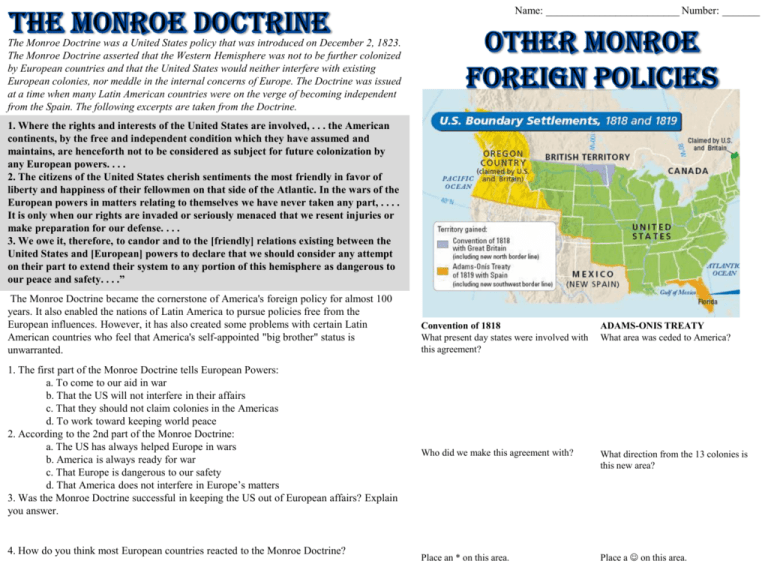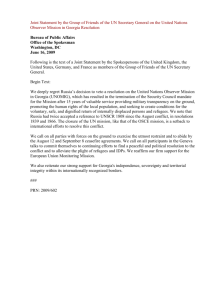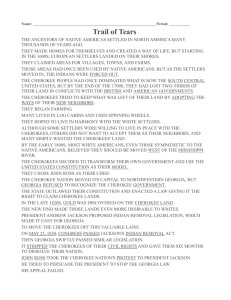The Monroe Doctrine was a United States policy that was introduced
advertisement

Name: _________________________ Number: _______ The Monroe Doctrine was a United States policy that was introduced on December 2, 1823. The Monroe Doctrine asserted that the Western Hemisphere was not to be further colonized by European countries and that the United States would neither interfere with existing European colonies, nor meddle in the internal concerns of Europe. The Doctrine was issued at a time when many Latin American countries were on the verge of becoming independent from the Spain. The following excerpts are taken from the Doctrine. 1. Where the rights and interests of the United States are involved, . . . the American continents, by the free and independent condition which they have assumed and maintains, are henceforth not to be considered as subject for future colonization by any European powers. . . . 2. The citizens of the United States cherish sentiments the most friendly in favor of liberty and happiness of their fellowmen on that side of the Atlantic. In the wars of the European powers in matters relating to themselves we have never taken any part, . . . . It is only when our rights are invaded or seriously menaced that we resent injuries or make preparation for our defense. . . . 3. We owe it, therefore, to candor and to the [friendly] relations existing between the United States and [European] powers to declare that we should consider any attempt on their part to extend their system to any portion of this hemisphere as dangerous to our peace and safety. . . .” The Monroe Doctrine became the cornerstone of America's foreign policy for almost 100 years. It also enabled the nations of Latin America to pursue policies free from the European influences. However, it has also created some problems with certain Latin American countries who feel that America's self-appointed "big brother" status is unwarranted. 1. The first part of the Monroe Doctrine tells European Powers: a. To come to our aid in war b. That the US will not interfere in their affairs c. That they should not claim colonies in the Americas d. To work toward keeping world peace 2. According to the 2nd part of the Monroe Doctrine: a. The US has always helped Europe in wars b. America is always ready for war c. That Europe is dangerous to our safety d. That America does not interfere in Europe’s matters 3. Was the Monroe Doctrine successful in keeping the US out of European affairs? Explain you answer. 4. How do you think most European countries reacted to the Monroe Doctrine? Convention of 1818 What present day states were involved with this agreement? ADAMS-ONIS TREATY What area was ceded to America? Who did we make this agreement with? What direction from the 13 colonies is this new area? Place an * on this area. Place a on this area. 3. Refer to Line 7. What did the Cherokee do in an attempt to declare their independence from Georgia? 1. 2. 3. 4. 5. 6. 7. 8. 9. 10. 11. 12. 13. 14. 15. 16. 17. 18. 19. 20. 21. 22. 23. 24. 25. 26. 27. 28. 29. 30. In the court case Worcester v. Georgia, the U.S. Supreme Court held in 1832 that the Cherokee Indians constituted (created) a nation holding distinct sovereign (independent) powers. Although the decision became the basis of the principle of tribal sovereignty in the twentieth century, it did not protect the Cherokees from being removed from their ancestral (family) homeland in the Southeast. In the 1820s and 1830s Georgia conducted (led) a relentless campaign to remove the Cherokees, who held territory within the borders of Georgia, North Carolina, Alabama, and Tennessee at the time. The Cherokees created their own constitution and claimed that they did not have to follow Georgia’s laws, because they were a sovereign nation. The state annexed (captured) the Cherokee lands; abolished (ended) their government, courts, and laws; and established a process for seizing Cherokee land and distributing it to the state's white citizens. In 1830 representatives from Georgia and the other southern states pushed through Congress the Indian Removal Act, which gave U.S. president Andrew Jackson the authority to negotiate (discuss) removal treaties with the Native American tribes. The Cherokees, led by their principal chief, John Ross, refused to remove and instead filed with the U.S. Supreme Court an action claiming that Georgia’s laws did not apply to the Cherokee. In Cherokee Nation v. Georgia (1831), the court held that it did not have jurisdiction to strike down Georgia's laws. Chief Justice John Marshall wrote that the Cherokees constituted a "domestic (local), dependent nation" that existed under the guardianship of the United States. In Worcester v. Georgia, the court struck down Georgia's extension laws. In the majority opinion, Chief Justice John Marshall wrote that the Indian nations were "distinct, independent political communities retaining (holding) their original natural rights". Marshall harshly rebuked (criticized) Georgia for its actions and declared that the Cherokees possessed the right to live free from the state's trespasses. The Cherokee leadership hoped the decision would persuade the federal government to intervene (interefere) against Georgia and end the talk of removal. Georgia ignored the Supreme Court's ruling and continued to press the federal government to remove the Cherokees. President Jackson did not enforce the decision against the state and instead called on the Cherokees to relocate (move) or fall under Georgia's jurisdiction (authority). In 1835 a dissident (rebellious) faction (group) of Cherokees signed a removal treaty at the Cherokee capital of New Echota. In 1838 the U.S. Army entered the Cherokee Nation, forcibly gathered almost all of the Cherokees, and marched them to the Indian Territory in present-day Oklahoma, in what became known as the Trail of Tears. Directions: Answer the questions based on the passage. Use the word bank below to help you interpret the passage. The parentheses guide you to where you should refer to the passage to find answers. 1. In the first sentence of the passage, you discover that the ruling (decision) of the Worcester v. Georgia court case is: The government decided that the Native Americans were their own nation that didn’t have to follow state laws. The government decided that the Native Americans were a nation that was part of the United States, and thus must follow state laws. 2. Refer to Lines 2-4. Did the ruling of the court case that you identified in #1 protect the Native Americans from being removed from their homeland? Yes No 4. Refer to Lines 8-10. What did Georgia do in response to the Cherokees actions that you described in #3? 5. Refer to Lines 11-12. What was the Indian Removal Act? 6. Refer to Lines 13-14. Who was John Ross and what did he do? Write your response in your own words. 7. Read Lines 18-20. Who delivered the Worcester v. Georgia decision, and what decision did he pass down for the Worcester v. Georgia court case? 8. Which of the following best describes the Native Americans’ hopes as a result of the court case decision? The Cherokee hoped it would provide them with the protection they needed to remain on their lands and safe from Georgians. The Cherokee hoped it would allow them to claim new land out west, away from the white citizens that they did not trust. 9. Refer to Lines 23-24. What was Georgia’s actual response/reaction to the Worcester v. Georgia court case? 10. Refer to Lines 25-26. Did President Andrew Jackson support the court case decision, or did he fight it? In your own words, write a sentence, using information from the passage, to support your answer. 11. Refer to Line 29. To where were the Native Americans relocated?







